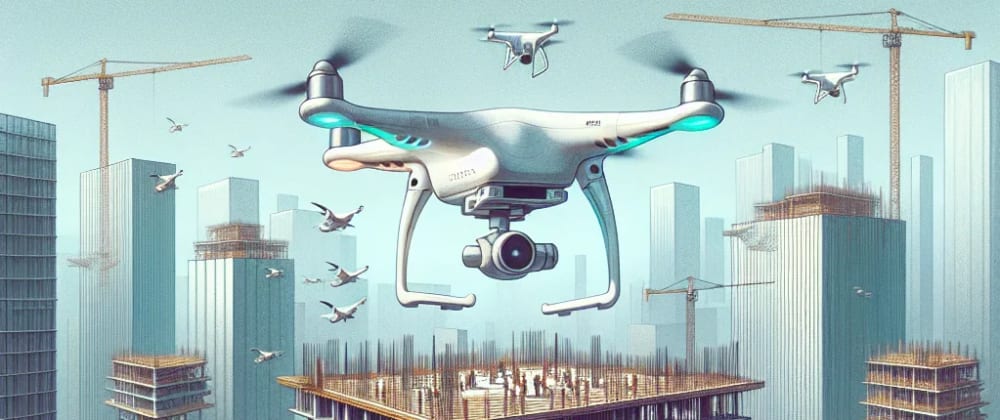How Drones are Changing the Face of Construction Site Management
Have you ever marveled at the humming sound of drones cutting through the air? Once regarded as the playthings of hobbyists and the tools of filmmakers, drones are now soaring into the high-stakes world of construction, bringing along a gust of innovation. From precise site surveys to real-time progress tracking, drones are not just changing the landscape; they are re-constructing it. Let’s take a closer look!
Aerial Surveys: More Than Just a Bird’s Eye View
Gone are the days when surveying a construction site meant laborious ground measurements and weeks of data processing. Today’s drones, equipped with advanced sensors and high-definition cameras, provide rapid and accurate aerial surveys.
Benefits of Drone Surveys:
- High Precision: Drones can capture detailed 3D models and topographical maps with sub-centimeter accuracy.
- Time Efficiency: Large areas that would take weeks to survey manually can be covered in a matter of hours.
- Cost-Effective: Reducing the number of man-hours required translates into significant cost savings.
Real-World Application:
For instance, a project in urban development can employ drones to map out existing structures and terrains. This allows architects to visualize their blueprints in the actual setting, tweaking designs based on real-world data before laying the first brick.
Real-Time Monitoring: Keeping an Eye on Progress
Imagine having a pair of eyes that can hover above your construction site, offering you a real-time, panoramic view of every nook and cranny. Drones make this possible.
Key Advantages:
- Progress Tracking: Regular drone flights can provide updated visual data, allowing project managers to track progress against timelines.
- Resource Management: By identifying areas of underutilization or bottlenecks, managers can redistribute resources more effectively.
- Stakeholder Engagement: Visual updates make it easier to keep stakeholders in the loop. Sharing real-time progress videos ensures transparency and builds trust.
Case Study:
Consider a large-scale highway construction project spread over hundreds of kilometers. Traditional methods of tracking such a vast site would be cumbersome. Drones can fly along the path of the project, capturing everything from the preparation of the foundation to the laying of asphalt, enabling precise monitoring and timely interventions.
Enhanced Safety: Minimizing Risks, Maximizing Security
Safety is a paramount concern in construction, and drones are proving to be invaluable in this aspect. Their ability to access hard-to-reach areas without putting human lives at risk is a game-changer.
Safety Enhancements:
- Hazard Identification: Regular drone inspections can identify potential safety hazards such as unstable structures or exposed electrical wires.
- Remote Inspections: Inspecting dangerous or hard-to-access areas remotely reduces the need for scaffolding or other risky equipment.
- Emergency Response: In case of accidents, drones can quickly survey the area to assess damage and identify safe access routes for emergency services.
Practical Example:
On a high-rise construction site, workers typically face the risk of falls or scaffold collapses. Drones equipped with thermal cameras can conduct inspections and detect structural anomalies, significantly reducing the risk to human inspectors.
Data-Driven Decisions: The Power of Analytics
Modern drones are not just about capturing images; they are about gathering data. Thanks to embedded sensors and smart software, drones can collect a wealth of data that, when analyzed, can lead to smarter and more informed decisions.
Analytical Capabilities:
- Predictive Analysis: Using machine learning algorithms, data collected from drone surveys can predict potential project delays or cost overruns.
- Quality Control: Drones can monitor construction quality in real-time, ensuring that projects adhere to design specifications and quality standards.
- Environmental Monitoring: They can also monitor environmental impact by tracking parameters like soil erosion, vegetation cover, and water runoff.
Impact in the Field:
Consider a scenario where a construction company needs to ensure compliance with environmental regulations. Drones can continuously monitor the site and provide data on environmental parameters. This data can feed into an analytical dashboard, alerting managers of any deviations and allowing them to take corrective actions promptly.
Future Trends: What Lies Ahead?
The evolution of drone technology in construction is just beginning. With advancements in AI, machine learning, and IoT integration, the future looks even more promising.
Upcoming Innovations:
- Autonomous Drones: These drones can fly pre-programmed routes and perform tasks like surveying, monitoring, and even material transport autonomously.
- AI Integration: Artificial Intelligence will allow drones to make real-time decisions, such as identifying and correcting construction errors on the fly.
- Swarm Technology: Imagine multiple drones working in tandem to complete complex tasks efficiently. Swarm technology could revolutionize site management.
Conclusion:
Drones are not merely gadgets; they are catalysts for a construction revolution. Their ability to provide real-time data, enhance safety, and drive cost-efficiency makes them indispensable in modern construction site management. As technology continues to advance, the sky's the limit for drones in this industry. So, the next time you hear that distinct buzzing sound above a construction site, remember, it's not just a drone; it's the future of construction taking flight!







Top comments (0)